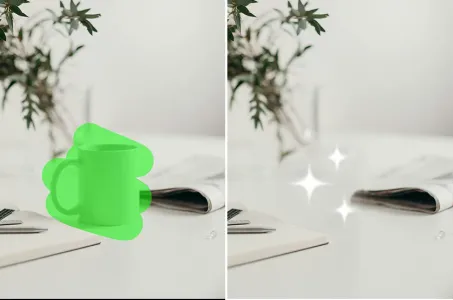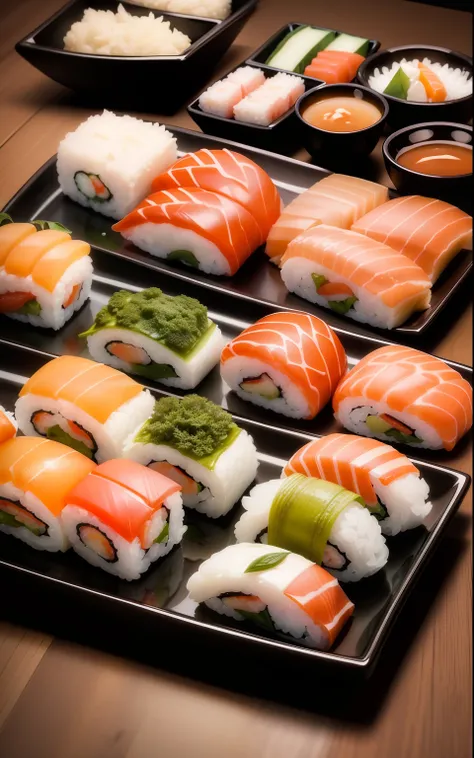Sushi is a variety of Japanese dishes. Each of them has different characteristic


Sushi is a variety of Japanese dishes. Each of them has different characteristics and methods of preparation. This is the most popular and famous type of sushi.: 1. Nikiri Sushi (Nigiri Sushi) Sushi rice that is molded into small cubes and then a piece of raw fish or other seafood is placed on top of the rice. Wasabi is often used between rice and fish fillets. Sometimes a string of tied seaweed may be used. 2. Makizushi (Maki Sushi) ข้าวซูชิและไส้ต่าง ๆ ที่ถูกม้วนด้วยสาหร่ายแห้งแล้วหั่นเป็นชิ้นเล็ก ๆ Makizushiมีหลายประเภท เช่น โฮโซมากิ (Hosomaki): Thin rolls often use a single filling, such as cucumber or tuna. Futomaki (Futomaki): Thick and large rolls. There are several types of fillings. Uramaki (Uramaki): Roll upside down. Rice is on the outside and algae is on the inside, like a California roll. 3. Sasimi (sashimi) Slices of raw fish or seafood cut into thin slices are served with wasabi and shoyu. Although not true sushi, they are often served in parallel. 4. เทMakizushi (Temaki Sushi) Rice, sushi and various fillings are rolled in dried seaweed in the form of a cone. Serve without cutting into slices. 5. OSHI SUSHI (Oshi Sushi) Rice, sushi and fish fillets are pressed in wooden boxes to get a neat shape. Then cut into slices. 6. Inari Sushi (Inari Sushi) Sushi rice is put in a bag of fried tofu. (Abura-age) which has a sweet taste. 7. Jirashi Sushi (Chirashi Sushi) Sushi rice is served in bowls and then garnished with meat of raw fish and various seafood, as well as various vegetables. 8. Kungkanmaki (Gunkan Maki) Sushi rice is molded into small circles and wrapped in seaweed so that it can be filled with fillings that look small or have a liquid appearance, such as eggs, fish or seafood salads. 9. Sushi omelette (Tamago Sushi) Sushi rice that is molded into cubes and tamako is placed (Japanese omelette) On rice 10. Ebisushi (Ebi Sushi) Sushi rice with blanched shrimp placed on rice. Small to medium shrimp are usually used.
Подсказки
Копировать подсказки
Sushi is a variety of Japanese dishes
.
Each of them has different characteristics and methods of preparation
.
This is the most popular and famous type of sushi
.
:
1
.
Nikiri Sushi (Nigiri Sushi)
Sushi rice that is molded into small cubes and then a piece of raw fish or other seafood is placed on top of the rice
.
Wasabi is often used between rice and fish fillets
.
Sometimes a string of tied seaweed may be used
.
2
.
Makizushi (Maki Sushi)
ข้าวซูชิและไส้ต่าง ๆ ที่ถูกม้วนด้วยสาหร่ายแห้งแล้วหั่นเป็นชิ้นเล็ก ๆ Makizushiมีหลายประเภท เช่น
โฮโซมากิ (Hosomaki): Thin rolls often use a single filling
,
such as cucumber or tuna
.
Futomaki (Futomaki): Thick and large rolls
.
There are several types of fillings
.
Uramaki (Uramaki): Roll upside down
.
Rice is on the outside and algae is on the inside
,
like a California roll
.
3
.
Sasimi (sashimi)
Slices of raw fish or seafood cut into thin slices are served with wasabi and shoyu
.
Although not true sushi
,
they are often served in parallel
.
4
.
เทMakizushi (Temaki Sushi)
Rice
,
sushi and various fillings are rolled in dried seaweed in the form of a cone
.
Serve without cutting into slices
.
5
.
OSHI SUSHI (Oshi Sushi)
Rice
,
sushi and fish fillets are pressed in wooden boxes to get a neat shape
.
Then cut into slices
.
6
.
Inari Sushi (Inari Sushi)
Sushi rice is put in a bag of fried tofu
.
(Abura-age) which has a sweet taste
.
7
.
Jirashi Sushi (Chirashi Sushi)
Sushi rice is served in bowls and then garnished with meat of raw fish and various seafood
,
as well as various vegetables
.
8
.
Kungkanmaki (Gunkan Maki)
Sushi rice is molded into small circles and wrapped in seaweed so that it can be filled with fillings that look small or have a liquid appearance
,
such as eggs
,
fish or seafood salads
.
9
.
Sushi omelette (Tamago Sushi)
Sushi rice that is molded into cubes and tamako is placed (Japanese omelette) On rice
10
.
Ebisushi (Ebi Sushi)
Sushi rice with blanched shrimp placed on rice
.
Small to medium shrimp are usually used
.
Информация
Checkpoint & LoRA

Checkpoint
Dream PhotoFX

LORA
FML Watercolor

LORA
Cute Ukiyo-e
#Реалистичный
#пища
0 комментариев
0
0
0











































